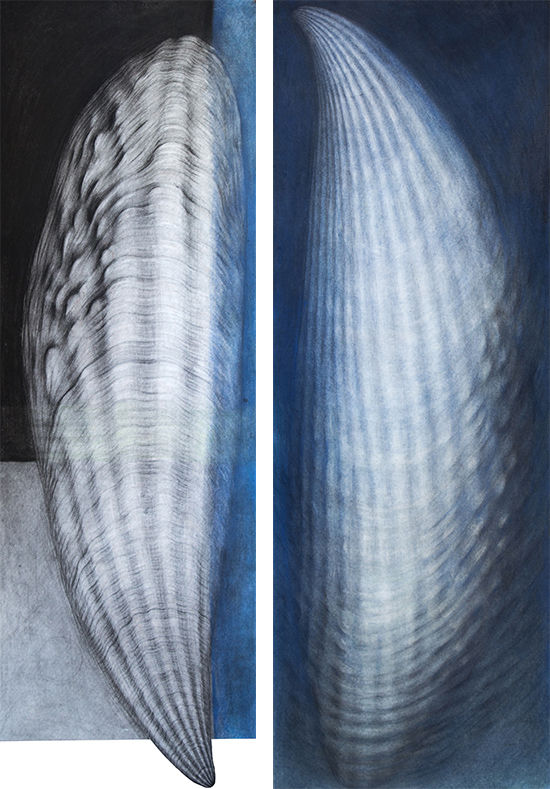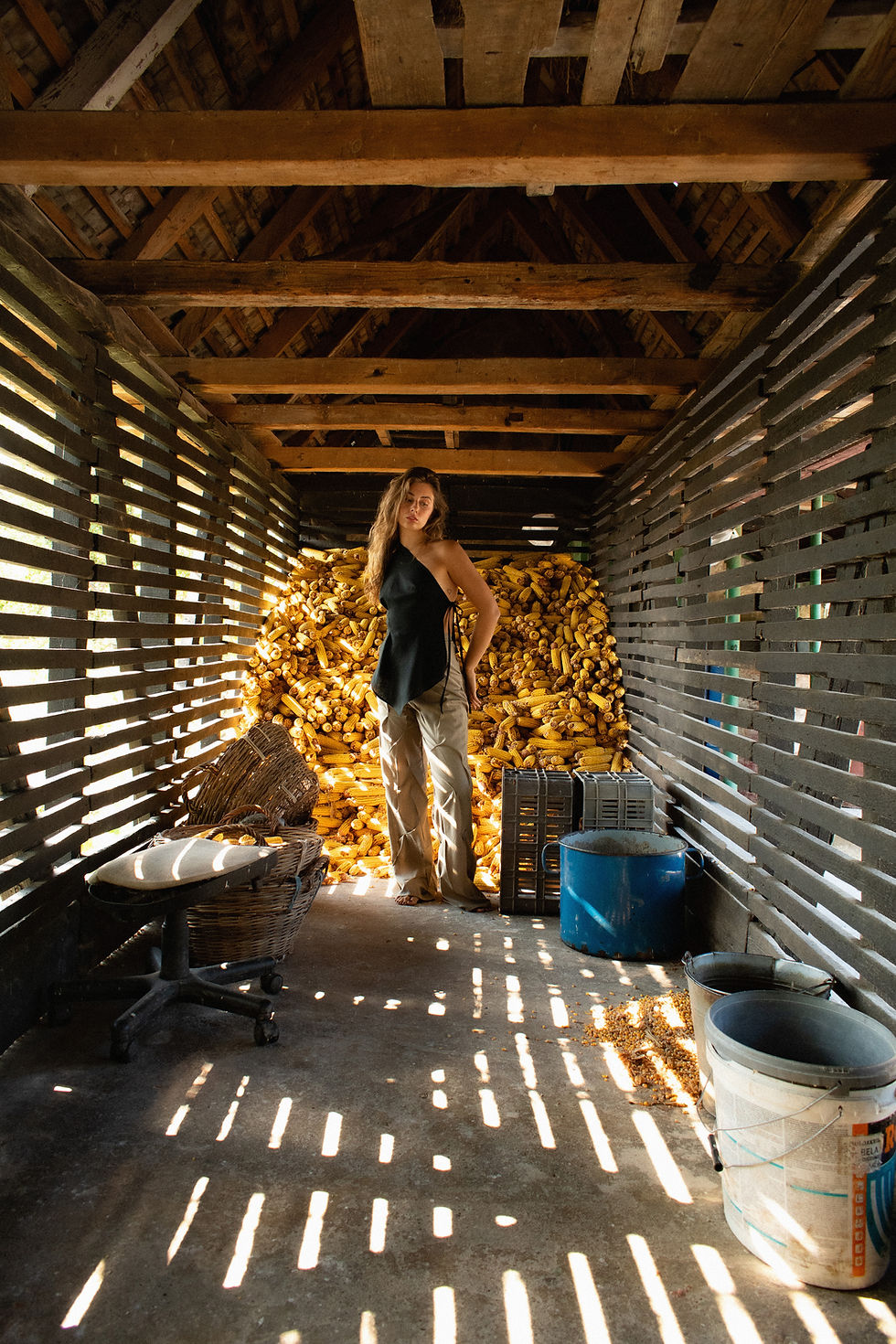Jana Stojanović’s Aesthetics of Nonhuman Systems
- Savina Ražnatović
- Oct 2
- 4 min read
Nonhuman systems have long conditioned how we see. What steadies us by the sea is not meaning but near-repetition—returns that are almost the same and never quite. Jana Stojanović sets her compositions on those returns. She borrows nature’s procedures: oscillation on water, shell-like accretion, the distributed order of a shoal. She rearticulates them through a gentle, measured hand in paint and charcoal. Repetition here is a mode of thinking—it shapes composition, sets tempo, and trains attention to difference at the edge of perception. As she puts it, “Repetition gives me calm, focus, and room for change while I am still in a safe zone.”
What you notice first is control of the mark. In the shell works, ribs and concentric time-rings accrete with held angles and measured gaps, until the surface reads like memory. She sets symbolism aside. The shell becomes time made visible. The same logic drives a large twisted form—part shell cross-section, part pressure field. Tight tonal steps move from near-white to deep black, so the image feels like a record of vibration. Nothing becomes schematic. Gradients stay soft, almost sfumato. Structure is sensed before it is named. This is her signature: a soft algorithm that holds the form and lets it breathe.
She focuses on three motifs: the shoal, the lily, the shell. In the lily works, she studies ripples—small touches making evenly spaced waves that change just slightly. The shell stores duration as matter: rings and mineral layers that keep speaking after life is gone. Each motif sets a rule, and each image tests how much variation the pattern can hold before it’s no longer itself. The logic stays fertile. She resists novelty for its own sake, committing instead to careful iteration—building continuity, accumulating knowledge, refining form. Rupture offers shock, then exhausts itself. Her method aims for steadiness and durability.




Water is the organizing medium: physics, metaphor, and origin. In the lily paintings, ripple fronts that are equidistant yet never identical spread from contact points. One vertical canvas shows a submerged hand touching the surface. A diptych shows a blade-thin cut in the pad, a chromatic wound. Elsewhere, a pale disc floats on a blood-red field while calm waves move outward. Surface tension becomes composition. The pad is painted as a membrane—crisp puckers, a fine vascular net under a soft gloss—an interface recording pressure, wind, light, and touch. The hand, when it appears, is not heroic. It resizes the scene to human perception, reminding us that spectatorship is a practice. Water, she notes, is “a carrier of information, our primal habitat.” The pictures behave accordingly. This places the work in dialogue with Northern Late Gothic painting. Slow tonal shifts, glaze-like depth, and diptych logic recall panel painting. The seam acts as hinge—dividing and rejoining. Dark grounds let forms rise from within, echoing Flemish glazing. The Bosch parallel is symbolic, not narrative. Membranes, shells, and watery thresholds act as passages. Bosch turns to last things; Stojanović turns to attention, where detail carries meaning.
Each series begins from a simple rule, repeated with small changes. The result is not mechanical serialism but embodied computation, paced to breath and patience. Repetition regulates. It creates calm while making room for change. She trusts slow differences over event economies. Her work is maintenance: adding a unit, laying another layer, taking responsibility for a form’s aftercare. Diptychs make this ethic visible. Two panels share a logic; the seam works like a metronome. Ripples cross it; gradients pause and resume. A lily’s diameter continues, then misses by a millimeter—just enough to reset attention. This is not theatre. It is care, keeping perception just above the noise floor. The shell cycle clarifies the point: duration is the content. Shells are not keepsakes, but records—matter that teaches time. Rings and ribs show accretion as structure. Their persistence models a tempo that ignores deadlines. The shell does not symbolize fertility or the sea. It works as spiral, rib, banding—and proposes an ethic of patience, record-keeping, modesty. Even endings follow the shell’s law. Works do not conclude. They thicken.
The pictures are rigorous and quiet, easily misread as contemplative. But their critique of speed is direct. Today’s image economies reward spectacle and output, turning difference into metrics. Stojanović proposes another tempo, where duration is not a deficit. The viewer is not asked to decode, but to tune—to adjust sensitivity until micro-variation becomes legible. Each exhibition functions less as a statement and more as a condition: a carefully set table where looking slows enough to taste. Edges and afterimages carry this lesson. In the elongated shell pair, one panel shimmers toward motion blur while the other reads as its echo. In the green and blue diptych, a thin cut across the pad is both wound and measured. In the vertical lily with the pointing hand, circular waves radiate as if audibility had been made visible. “I want viewers to experience themselves, not my intention,” she has said. The works create that space.
To call this an aesthetics of nonhuman systems sets orientation, not theme. Learn from forms that endure without command. Let oscillation replace the event. Let accretion replace climax. Across the media, Stojanović composes order that is felt, not imposed—coherence without rigidity, motion without drama, memory without grievance. The social claim is modest and exacting. A culture running at speed confuses quantity with change, spectacle with value. She offers another tempo: iteration as attention, pattern as knowledge, duration as critique. The works promise no redemption. They propose exercises in low-amplitude change—held long enough for it to register. If attention is scarce, repetition is a method and ethic. Asked if a series ends, she once answered, “Never.” That is not rhetoric. It is a procedure.
Jana Stojanović (b. 1998, Belgrade) earned her BA (2021), MFA (2022), and is currently pursuing doctoral studies at the Faculty of Fine Arts, University of Arts in Belgrade. She previously trained as a visual technician at the School of Design, Belgrade (2013–2017). Her work has been recognized with the FLU Award for Painting (2019), the FLU Award for Mosaic (2021), and the Tesla Scientific Foundation Award (2024). She is a recipient of national and city scholarships, including the "Dositeja" and NIO—Young Researchers grants. Stojanović is a member of ULUS (since 2024), and her work has been exhibited widely, with recent solo shows at Galerija Nikola Radošević, Galerija ŠTAB, and Galerija 73.






Comments